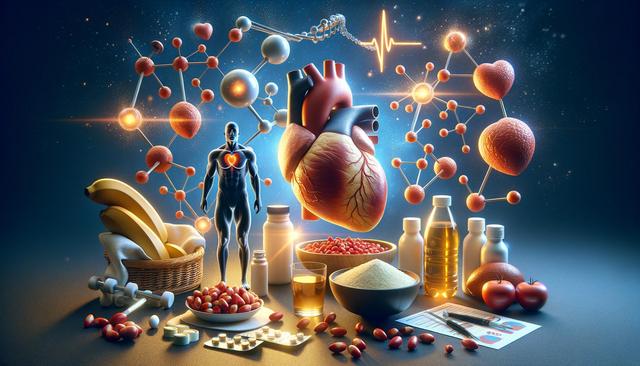What Is Cholesterol?
Cholesterol is a waxy, fat-like substance that is found in every cell of the body. It plays a vital role in producing hormones, vitamin D, and substances that help digest food. Although it is essential for various bodily functions, too much cholesterol in the blood can increase the risk of heart disease. The body produces all the cholesterol it needs in the liver, but it is also found in animal-based foods such as meat, dairy, and eggs. Understanding the sources of cholesterol is important for managing intake and supporting heart health.
There are two main ways the body gets cholesterol: through natural production in the liver and from dietary sources. While the body regulates cholesterol levels to some extent, dietary habits can have a significant impact. A diet high in saturated and trans fats can lead to elevated cholesterol levels, which may increase the likelihood of plaque buildup in the arteries. This buildup, known as atherosclerosis, can reduce or block blood flow, potentially resulting in heart attacks or strokes.
The Different Types of Cholesterol
Cholesterol is carried through the bloodstream by particles called lipoproteins. The two most commonly discussed types are low-density lipoprotein (LDL) and high-density lipoprotein (HDL). Each plays a different role in heart health, and understanding the difference can help guide lifestyle and dietary choices.
Here’s a breakdown of the main types:
- Low-Density Lipoprotein (LDL): Often referred to as “bad” cholesterol because it can lead to plaque buildup in the arteries.
- High-Density Lipoprotein (HDL): Known as “good” cholesterol because it helps remove LDL cholesterol from the arteries and transports it back to the liver.
- Triglycerides: A type of fat in the blood that, when elevated along with high LDL or low HDL, can further increase the risk of heart disease.
Maintaining a balance between these types is key to supporting cardiovascular health. Monitoring and managing these levels through routine check-ups and lifestyle choices is a proactive step toward long-term heart wellness.
Understanding Cholesterol Levels
Cholesterol levels are typically measured through a blood test known as a lipid panel. This test provides readings for total cholesterol, LDL, HDL, and triglycerides. Each component offers useful insights into heart health, and the results are interpreted based on established medical guidelines. Knowing these numbers can help individuals make informed decisions about diet, exercise, and other lifestyle factors.
General guidelines for cholesterol levels include:
- Total cholesterol: Ideally below 200 mg/dL
- LDL cholesterol: Ideally below 100 mg/dL
- HDL cholesterol: Ideally 60 mg/dL or higher
- Triglycerides: Ideally below 150 mg/dL
It’s important to note that these values may vary depending on individual health conditions and risk factors. For instance, those with a history of heart disease or diabetes may be advised to aim for even lower LDL targets. Regular screenings, especially for individuals over 20, can detect imbalances early and help guide necessary adjustments in lifestyle and, if needed, medical treatment.
Lifestyle Factors That Influence Cholesterol
Several lifestyle choices can directly impact cholesterol levels and, by extension, heart health. Making small, sustainable changes can lead to meaningful improvements over time. Diet, physical activity, and weight management are among the most influential factors in maintaining healthy cholesterol levels.
Key strategies for supporting cholesterol balance include:
- Eating a heart-friendly diet: Incorporate more fruits, vegetables, whole grains, and healthy fats such as those found in nuts and olive oil. Limit intake of saturated fats, trans fats, and dietary cholesterol.
- Staying physically active: Aim for at least 150 minutes of moderate-intensity aerobic activity each week, such as brisk walking or cycling.
- Maintaining a healthy weight: Excess weight can contribute to higher LDL and triglyceride levels while lowering HDL cholesterol.
- Quitting smoking and limiting alcohol: Smoking reduces HDL levels, while excessive alcohol intake can raise triglycerides.
By incorporating these habits into daily life, individuals can support not only their cholesterol levels but also overall cardiovascular and metabolic health.
When to Seek Medical Guidance
While lifestyle changes are often effective in managing cholesterol, there are situations where medical intervention may be necessary. For individuals with significantly elevated levels or those at high risk of heart disease, healthcare providers may recommend additional measures, including prescription medication. These treatments are designed to reduce LDL levels and help prevent complications related to cardiovascular disease.
Situations where medical advice is particularly important include:
- Family history of high cholesterol or early heart disease
- Personal history of heart attack, stroke, or high blood pressure
- Presence of conditions like diabetes or chronic kidney disease
- Cholesterol levels that remain high despite lifestyle changes
Working with a healthcare provider allows for a tailored approach to cholesterol management. This may include regular monitoring, medication when appropriate, and support in setting achievable health goals. Early detection and proactive management can make a significant difference in long-term outcomes.
Conclusion
Understanding cholesterol and its impact on heart health empowers individuals to take meaningful steps toward wellness. While cholesterol is essential for many bodily functions, maintaining balanced levels is important to reduce the risk of heart disease. By staying informed, adopting heart-healthy habits, and seeking medical guidance when needed, individuals can make thoughtful choices that support long-term cardiovascular health. Regular check-ups, a balanced diet, and active living are powerful tools in building a heart-smart lifestyle.






